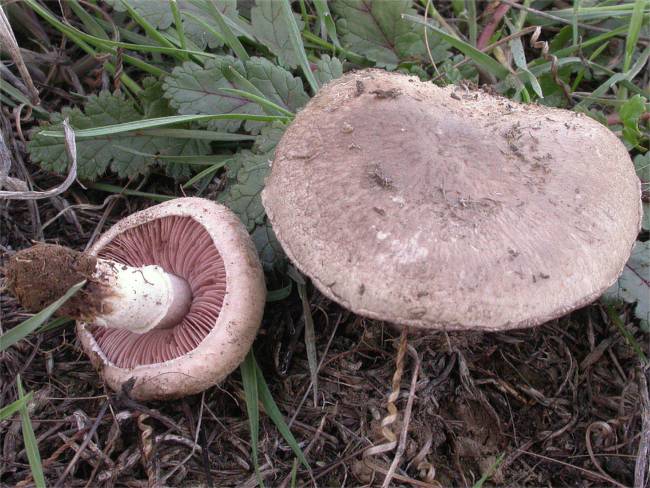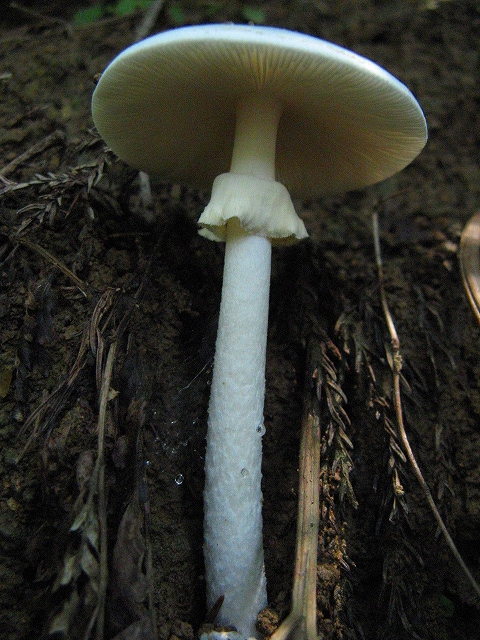|
Agaricales
The Agaricales are an order (biology), order of fungi in the division (mycology), division Basidiomycota. As originally conceived, the order contained all the agarics (gilled mushrooms), but subsequent research has shown that not all agarics are closely related and some belong in other orders, such as the Russulales and Boletales. Conversely, DNA research has also shown that many non-agarics, including some of the clavarioid fungi (clubs and corals) and gasteroid fungi (puffballs and false truffles) belong within the Agaricales. The order has 46 Extant taxon, extant family (biology), families, more than 400 genus, genera, and over 25,000 described species, along with six extinct genera known only from the fossil record. Species in the Agaricales range from the familiar ''Agaricus bisporus'' (cultivated mushroom) and the deadly ''Amanita virosa'' (destroying angel) to the coral-like ''Clavaria zollingeri'' (violet coral) and bracket-like ''Fistulina hepatica'' (beefsteak fungus). H ... [...More Info...] [...Related Items...] OR: [Wikipedia] [Google] [Baidu] |
List Of Agaricales Genera
This is a list of fungal genus, genera in the order (biology), order Agaricales. The list follows Kalichman, Kirk & Matheny (2020), with more recent additions and amendments, as noted. The number of species in each family is taken from Catalogue of Life (2023) and is subject to change as new research is published. Many genera are not as yet assigned to a family and are listed under "incertae sedis". Genera * See also *List of Agaricales families References Notes References {{reflist, 2, refs= {{cite journal , last=Agerer , first=R. , year=1983 , title=Beitrag zur Flora cyphelloider Pilze aus der Neotropis V. Zwei neue Gattungen: ''Metulocyphella'' und ''Incrustocalyptella'' , journal=Zeitschrift für Mykologie , volume=49 , issue=2 , pages=155–164 , language=de , trans-title=Contribution to neotropical cyphelloid fungi V. Two new genera: ''Metulocyphella'' and ''Incrustocalyptella'' {{cite journal , last=Agerer , first=R. , year=1983 , title=Typusstudien an cyphelloiden Pil ... [...More Info...] [...Related Items...] OR: [Wikipedia] [Google] [Baidu] |
List Of Agaricales Families
The Agaricales are an order (biology), order of fungus, fungi in the class Agaricomycetes (division Basidiomycota). It is the largest group of mushroom-forming fungi, and includes more than 600 genus, genera and over 25,000 species. Molecular, Molecular phylogenetics analyses of ribosomal DNA sequences have led to advances in our understanding of the Agaricales, and substantially revised earlier assessments of family (biology), families and genera. The following families are in the Agaricales, according to Kalichman, Kirk & Matheny (2020), with more recent additions and amendments, as noted. The number of genera and species in each family is taken from Catalogue of Life (2023), unless otherwise noted, and is subject to change as new research is published. Many genera are not as yet assigned to a family. Families See also *List of Agaricales genera Notes References Literature cited * * * * * {{cite book , author=Lotsy JP. , title=Vorträge über ... [...More Info...] [...Related Items...] OR: [Wikipedia] [Google] [Baidu] |
Agarics
An agaric () is a type of fungal fruiting body characterized by the presence of a pileus (cap) that is clearly differentiated from the stipe (stalk), with lamellae (gills) on the underside of the pileus. It is a type of mushroom (or toadstool), the diverse group of agarics being lumped together as gilled mushrooms. "Agaric" can also refer more generally to any basidiomycete species characterized by an agaric-type fruiting body. Etymology Originally, agaric meant 'tree-fungus' (after Latin ''agaricum''); however, that changed with the Linnaean interpretation in 1753 when Linnaeus used the generic name ''Agaricus'' for gilled mushrooms. Taxonomy Most species of agarics belong to the order Agaricales in the subphylum Agaricomycotina. The exceptions, where agarics have evolved independently, feature largely in the orders Russulales, Boletales, Hymenochaetales, and several other groups of basidiomycetes. Old systems of classification placed all agarics in the Agaricales and som ... [...More Info...] [...Related Items...] OR: [Wikipedia] [Google] [Baidu] |
Agaricaceae
The Agaricaceae are a family of basidiomycete fungi and include the genus ''Agaricus'', as well as basidiomycetes previously classified in the families Tulostomataceae, Lepiotaceae, and Lycoperdaceae. Taxonomy The family Agaricaceae was published by French botanist François Fulgis Chevallier in 1826. It is named after the type genus ''Agaricus'', originally circumscribed by Carl Linnaeus in his 1753 work ''Species Plantarum''. In his authoritative 1986 classification of the Agaricales, Rolf Singer divided the Agaricaceae into four tribes distinguished largely by spore color: ''Leucocoprineae'', ''Agariceae'', ''Lepioteae'', and ''Cystodermateae''. Genera once classified in the families Tulostomataceae, Battarreaceae, Lycoperdaceae, and Mycenastraceae have since been moved to the Agaricaceae based on molecular phylogenetics studies. According to a standard reference text, the Agaricaceae contains 85 genera and 1340 species. Description Agaricaceae species use a wide variety of ... [...More Info...] [...Related Items...] OR: [Wikipedia] [Google] [Baidu] |
Agaricus
''Agaricus'' is a genus of mushroom-forming fungi containing both edible and poisonous species, with over 400 members worldwide and possibly again as many disputed or newly discovered species. The genus includes the common ("button") mushroom ('' A. bisporus'') and the field mushroom ('' A. campestris''), the dominant cultivated mushrooms of the West. Taxonomy Several origins of genus name ''Agaricus'' have been proposed. It possibly originates from ancient Sarmatia Europaea, where people Agari, promontory Agarum and a river Agarus were known (all located on the northern shore of Sea of Azov, probably, near modern Berdiansk in Ukraine). Note also Greek , agarikón, "a sort of tree fungus" (There has been an ''Agaricon'' Adans. genus, treated by Donk in ''Persoonia'' 1:180.) For many years, members of the genus ''Agaricus'' were given the generic name ''Psalliota'', and this can still be seen in older books on mushrooms. All proposals to conserve ''Agaricus' ... [...More Info...] [...Related Items...] OR: [Wikipedia] [Google] [Baidu] |
Russulales
The Russulales are an order of the Agaricomycetes, (which include the agaric genera '' Russula'' and ''Lactarius'' and their polyporoid and corticioid relatives). According to the ''Dictionary of the Fungi'' (10th edition, 2008), the order consists of 12 families, 80 genera, and 1767 species. According to ''Species Fungorum'' (January 2016), the order contains 13 families, 117 genera (16 not assigned to a family), and 3,060 species. Russuloid agarics represent an independent evolutionary line of agarics, not directly related to the Agaricales. This group also includes a number of russuloid hypogeous fungi, polypores such as '' Bondarzewia'', some tooth fungi (e.g. '' Auriscalpium vulgare''), and club fungi e.g. '' Artomyces''. Basidiospores in this group are typically ornamented with amyloid warts or reticulation but a few exceptions are known, e.g. '' Heterobasidion annosum''. The genus '' Clavicorona'' was often treated in the Russulales, but its type species, '' C. ... [...More Info...] [...Related Items...] OR: [Wikipedia] [Google] [Baidu] |
Agaricus Campestris
''Agaricus campestris'' is a widely eaten gilled mushroom closely related to the cultivated '' A. bisporus'' (button mushroom). ''A. campestris'' is commonly known as the field mushroom or, in North America, meadow mushroom. It is edible but resembles some poisonous species. Taxonomy This species was originally noted and named in 1753 by Carl Linnaeus as ''Agaricus campestris''. It was placed in the genus '' Psalliota'' by Lucien Quelet in 1872. Some variants have been isolated over the years, a few of which now have species status, for example, '' Agaricus bernardii'' Quel. (1878), '' Agaricus bisporus'' (J.E. Lange) Imbach (1946), '' Agaricus bitorquis'' (Quel.) Sacc. (1887), '' Agaricus cappellianus'' Hlavacek (1987), and '' Agaricus silvicola'' (Vittad.) Peck (1872). Some were so similar they did not warrant even varietal status, while others have retained it. ''Agaricus campestris'' var. ''equestris'' (F.H.Moller) Pilat (1951) is still valid. ''A. ca ... [...More Info...] [...Related Items...] OR: [Wikipedia] [Google] [Baidu] |
Fistulina Hepatica
''Fistulina hepatica'', commonly known as the beefsteak fungus, beefsteak polypore, poor man's steak, ox tongue, or tongue mushroom, is a bracket fungus classified in the Agaricales. As its common names suggest, it visually resembles a slab of meat. The species can be found in Europe, Africa, Australia, and North America. It is edible when cooked, although older specimens may need special preparation. Taxonomy ''Fistulina'' is classified in the family Fistulinaceae; molecular studies suggest close relations to the ''agaric'' mushroom '' Schizophyllum'' in the Schizophyllaceae (in the ''schizophylloid'' clade), but in the separate sister ''fistulinoid'' clade. ''Fistulina'' is a cyphelloid genus, meaning that it is closely related to gilled fungi, but its fertile surface consists of smooth cup-shaped elements instead of gills. The underside (the hymenium) is a mass of tubules which represent a "reduced" form of the ancestral gills. Etymology The genus name is a dim ... [...More Info...] [...Related Items...] OR: [Wikipedia] [Google] [Baidu] |
Amanita Virosa
''Amanita virosa'' is a species of fungus in the class Agaricomycetes. In the UK, it has the recommended English name of destroying angel and is known internationally as the European destroying angel. Basidiocarps (fruit bodies) are agaricoid (mushroom-shaped) and pure white with a ring on the stem and a sack-like volva at the base. The species occurs in Europe and northern Asia. It was formerly reported from North America, but similar-looking American species like '' A. bisporigera'' and '' A. ocreata'' are distinct. As the name suggests, the destroying angel is poisonous. Taxonomy ''Amanita virosa'' was first described in 1838 by Swedish mycologist Elias Magnus Fries as ''Agaricus virosus'', but this name is illegitimate since it had already been used for an earlier and different species. ''Amanita virosa'' was legitimately published by French mycologist Louis-Adolphe Bertillon in 1866. Etymology The specific epithet is derived from the Latin adjective ''virōsu ... [...More Info...] [...Related Items...] OR: [Wikipedia] [Google] [Baidu] |
Clavaria Zollingeri
''Clavaria zollingeri'', commonly known as the violet coral or the magenta coral, is a widely distributed species of fungus. It produces striking tubular, purple to pinkish-violet basidiocarp, fruit bodies that grow up to tall and wide. The extreme tips of the fragile, slender branches are usually rounded and brownish. Variations in branching and color can often be used to distinguish ''C. zollingeri'' from similarly colored coral fungi such as ''Alloclavaria purpurea'' and ''Clavulina amethystina'', although light microscopy, microscopy is required to reliably identify the latter species. A typical member of the Clavarioid fungi, clavarioid or club fungi, ''C. zollingeri'' is Saprotrophic nutrition, saprobic, deriving nutrients by breaking down organic matter. The fruit bodies are typically found growing on the ground in woodland Forest floor, litter or in grasslands. Taxonomy The species was first described scientifically by French mycologist Joseph-Henri Léveil ... [...More Info...] [...Related Items...] OR: [Wikipedia] [Google] [Baidu] |
Systema Mycologicum
Systema Mycologicum is a systematic classification of fungi drawn up in 1821 by the Swedish mycologist and botanist Elias Fries Elias Magnus Fries (15 August 1794 – 8 February 1878) was a Swedish mycologist and botanist. He is sometimes called the "Linnaeus of Mycology". In his works he described and assigned botanical names to hundreds of fungus and lichen sp .... It took 11 years to complete. References External linksSystema Mycologicum at biodiversitylibrary.org Mycological literature {{fungus-book-stub ... [...More Info...] [...Related Items...] OR: [Wikipedia] [Google] [Baidu] |
Aptian
The Aptian is an age (geology), age in the geologic timescale or a stage (stratigraphy), stage in the stratigraphic column. It is a subdivision of the Early Cretaceous, Early or Lower Cretaceous epoch (geology), Epoch or series (stratigraphy), Series and encompasses the time from 121.4 ± 1.0 annum, Ma to 113.0 ± 1.0 Ma (million years ago), approximately. The Aptian succeeds the Barremian and precedes the Albian, all part of the Lower/Early Cretaceous. The Aptian partly overlaps the upper part of the Western Europe, Western European Urgonian Stage. The Selli Event, also known as OAE1a, was one of two oceanic anoxic events in the Cretaceous Period, which occurred around 120 annum, Ma and lasted approximately 1 to 1.3 million years, being marked by enhanced silicate weathering, as well as ocean acidification. The Aptian extinction was a minor extinction event hypothesized to have occurred around 116 to 117 Ma. Stratigraphic definitions The Aptian was named after the small city o ... [...More Info...] [...Related Items...] OR: [Wikipedia] [Google] [Baidu] |






